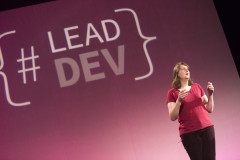SESSION + Live Q&A
Observable JS Apps
Observability isn't just for backends. Client-side javascript applications are the original distributed systems software: real-time, heavily cached, single-paged, asynchronous, multi-domain, with polyglot persistence layers and cascading dependencies and always running massive amounts of JS. So what can we borrow from backend observability practices, in order to better understand our users and how they really experience our applications? How can we get our finger on the pulse of modern JS apps running in production?
Observability means instrumenting your code so that you can ask any question, whether you anticipated it or not, and understand the internal state of your systems just by observing its outputs. Emily will talk about an event-driven approach to client-side observability for the most complicated parts of Honeycomb's customer-facing React app: the query builder. She will cover instrumentation best practices, what data to collect and why (spoiler alert: high cardinality is queen), and how they use that data to slice and dice and zoom in on some of the strangest unknown-unknowns for real customers. Code examples will be primarily in React or vanilla JS, but takeaways will apply to other popular frameworks. Examples will be in Honeycomb, but context is relevant to distributed tracing and other distsys debugging techniques.
Speaker

Emily Nakashima
Engineer @Honeycomb & Co-Organizer of the AndConf Code Retreat / Unconference
Emily manages the frontend/web/product engineering team at Honeycomb.io. In the past, she's worked on javascript, web perf and monitoring at companies like Bugsnag & GitHub. In her free time she organizes an unconference called AndConf, makes many checklists, and likes to talk about disaster...
Read moreFrom the same track
WebAssembly (And the Death of JavaScript?)
JavaScript brought interactivity to the web more than 20 years ago, and despite numerous challengers, it is still the only language supported by browser. However, as those 20 years have passed we've moved from adding a little interactivity to largely static sites, to creating complex...

Colin Eberhardt
CTO @Scott_Logic
Reinventing npmjs.com
The npm website has some catching up to do. It began as the homepage for a fledgling open source project and it has grown to become the foremost resource for over 600,000 packages in the npm registry. It now needs to keep up with the expectations of modern users and evolve into something...

Katie Fenn
Software Engineer @npm
JavaScript Open Space
Enterprise Node.JS Apps in 2018
This talk is a candid and entertaining look at challenges facing node.js app developers in 2018. Reflecting on experiences building PayPal’s Send Money app we’ll look at how we respond to memory leaks, server crashes and bugs that only seem to reproduce on production. I’ll also address how...

Jamund Ferguson
JS Architect @PayPal
Parallelizing Product Development with GraphQL
In this talk we will cover how to drive API development forward with the data model as the source of truth using the GraphQL Schema Definition Language. In typical REST approaches, UI development is often blocked on APIs and API development is hampered by not knowing how clients are using the...

Chris Biscardi
Product Engineer @Honeycomb

